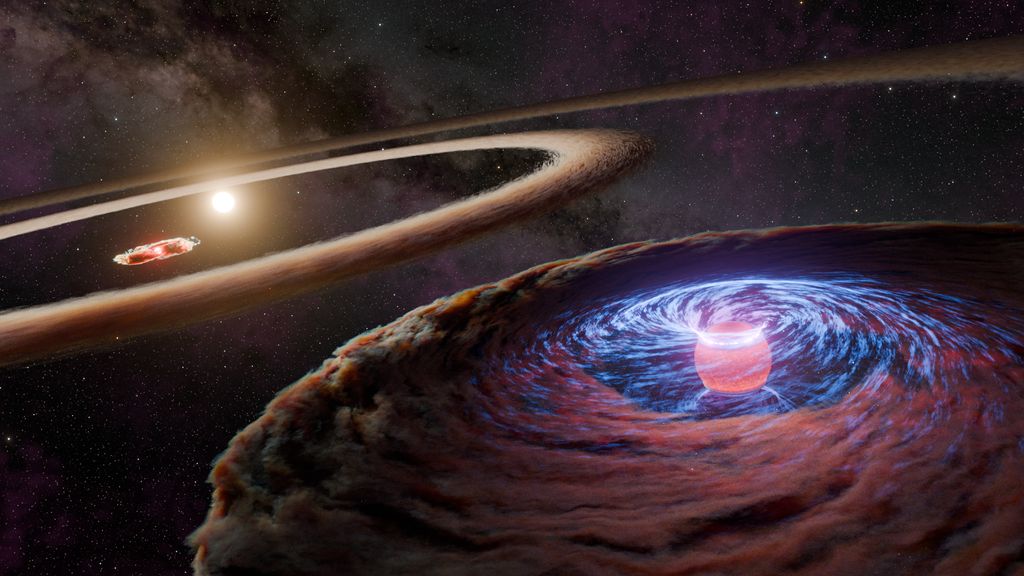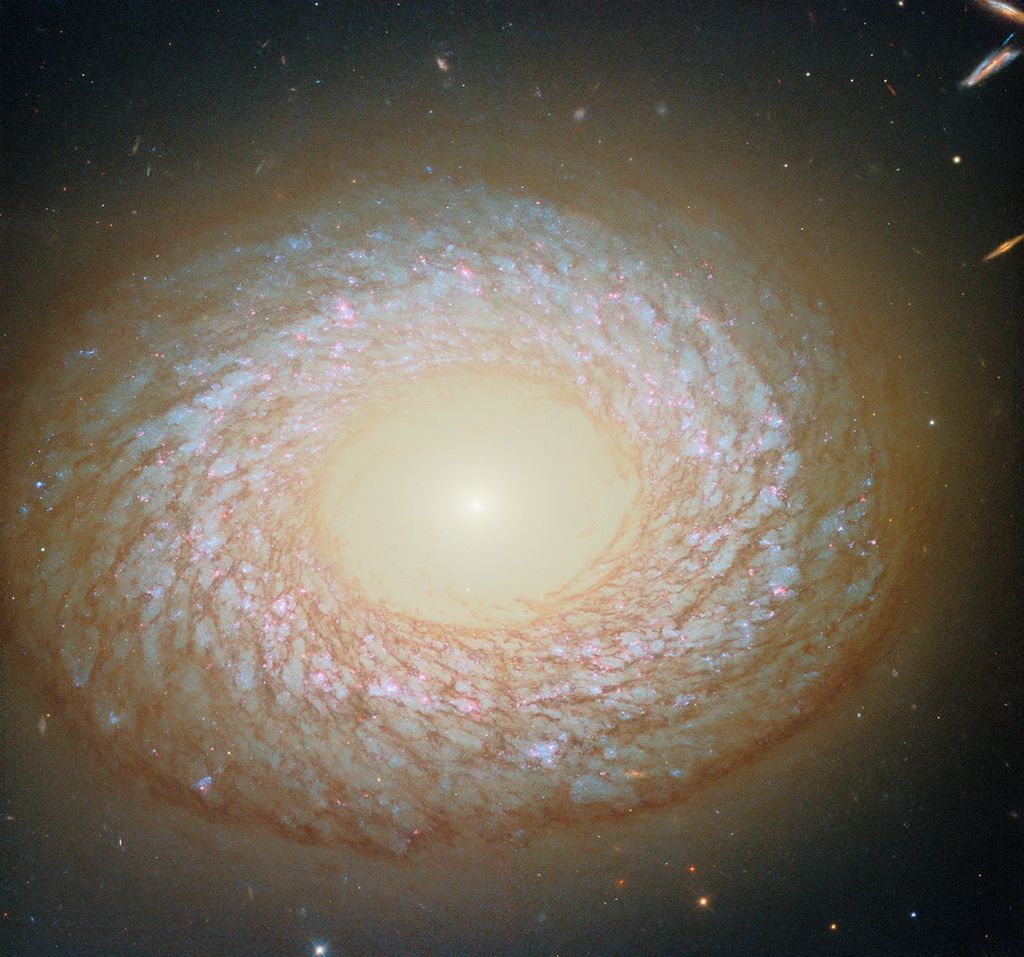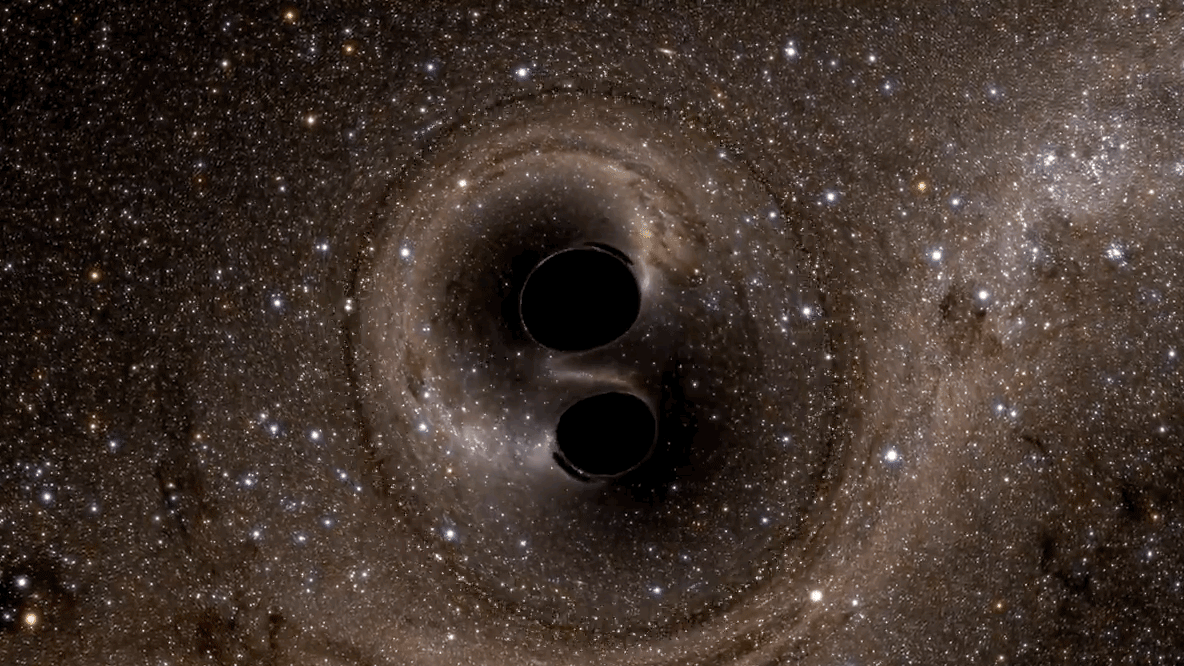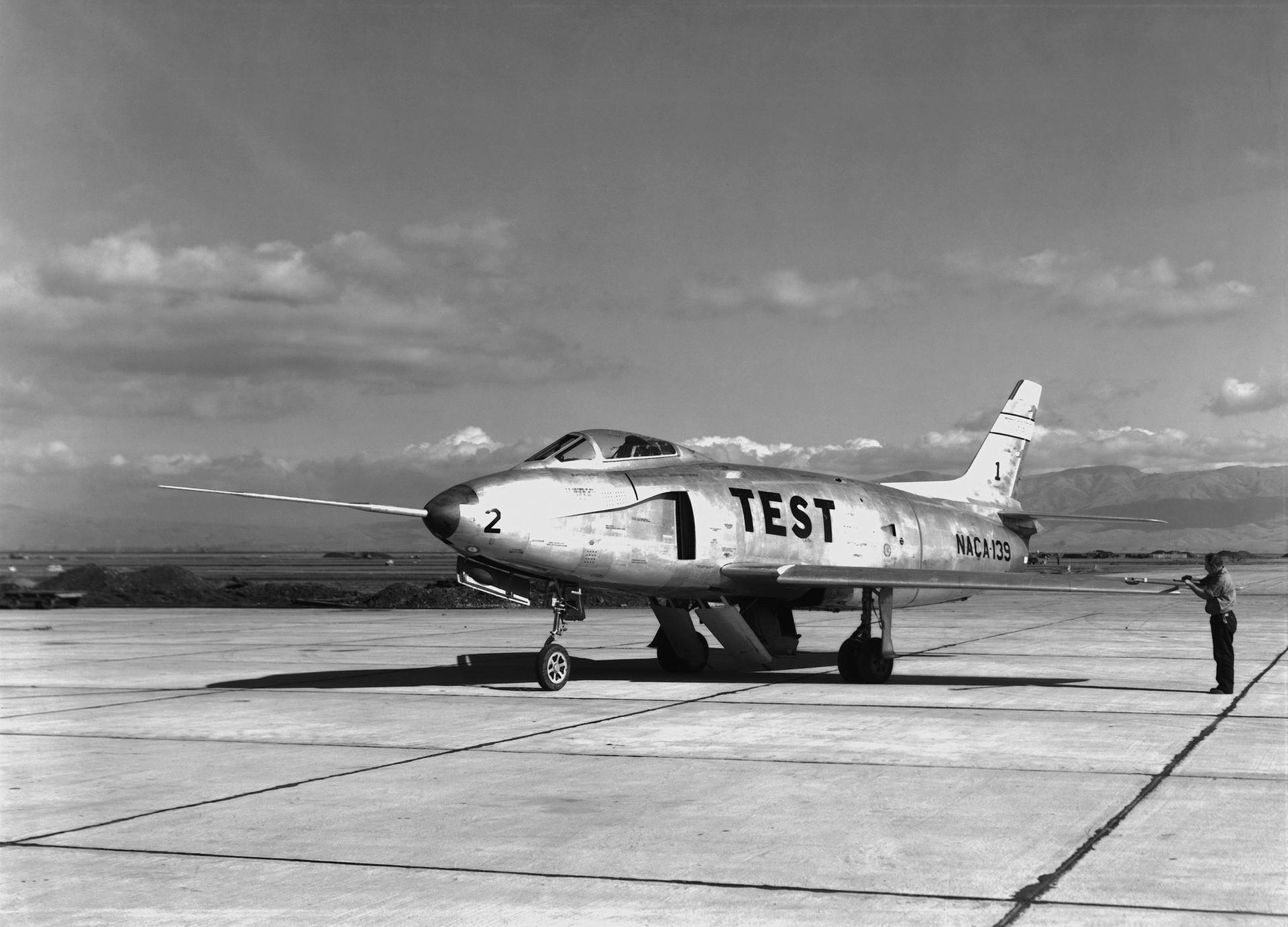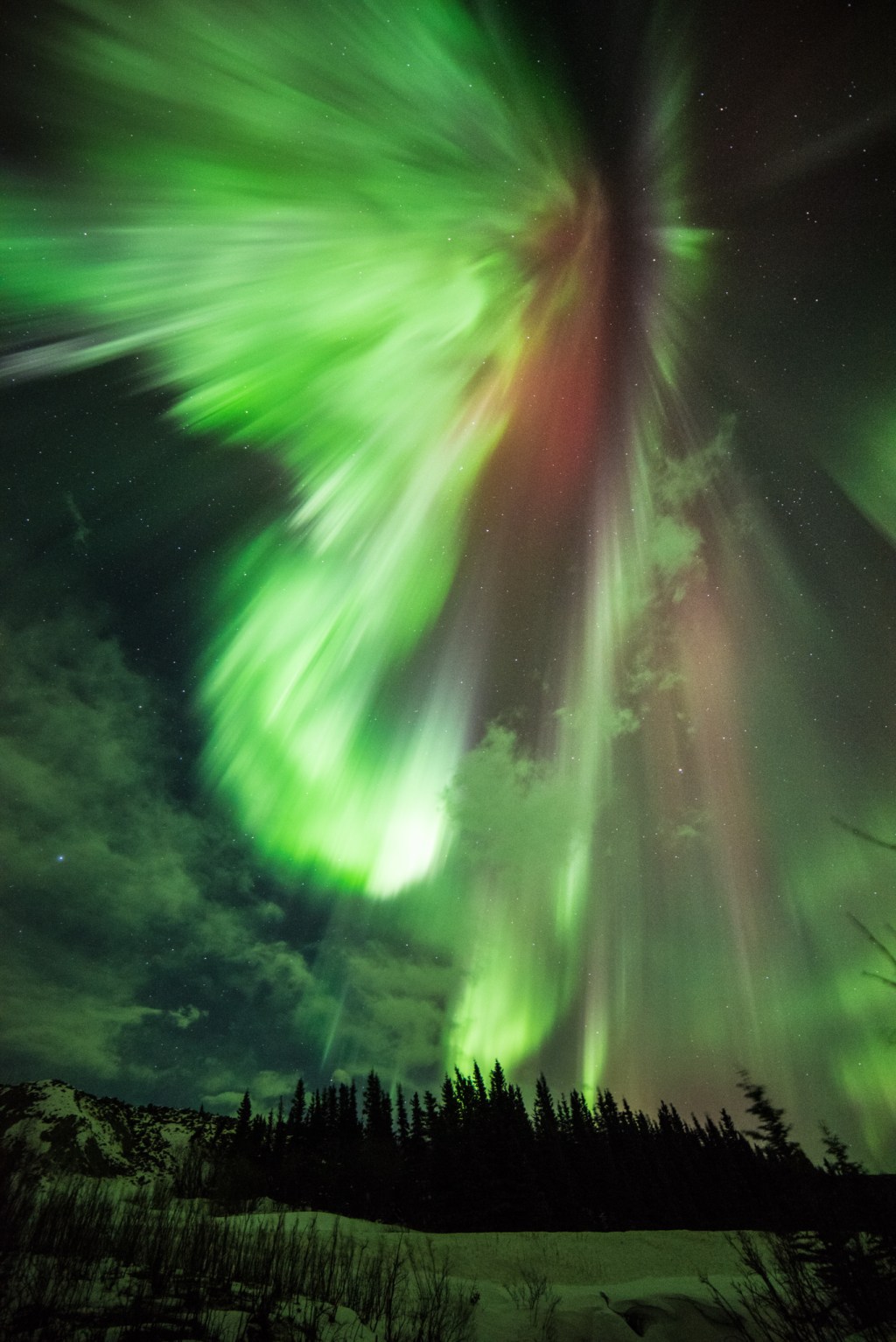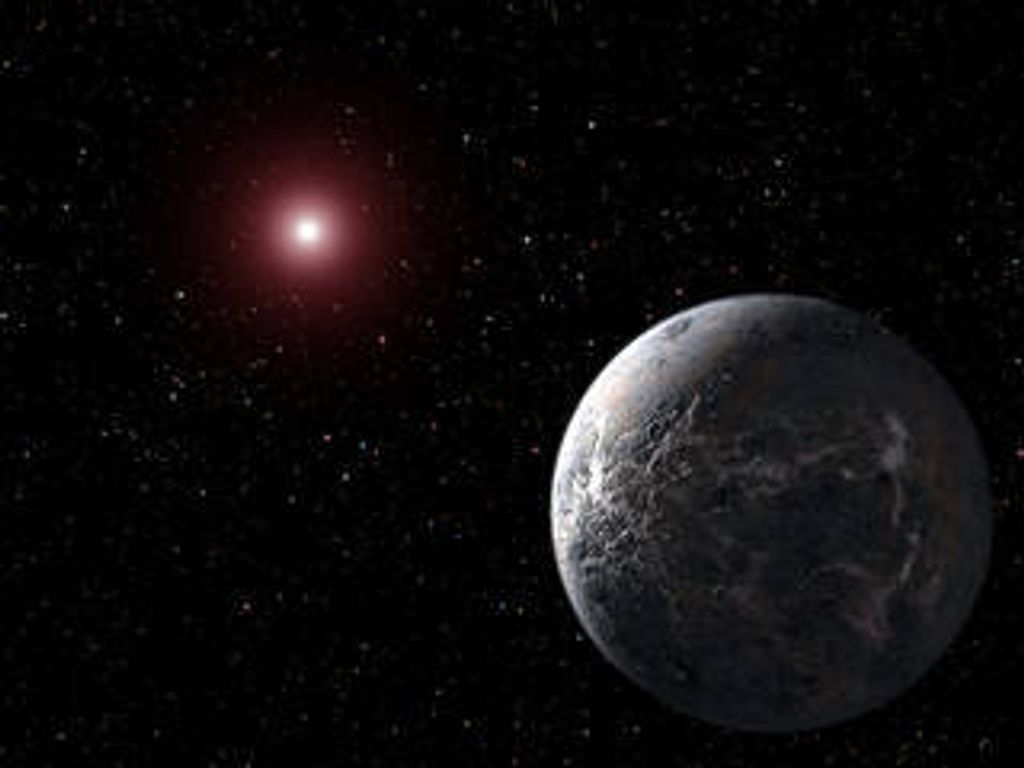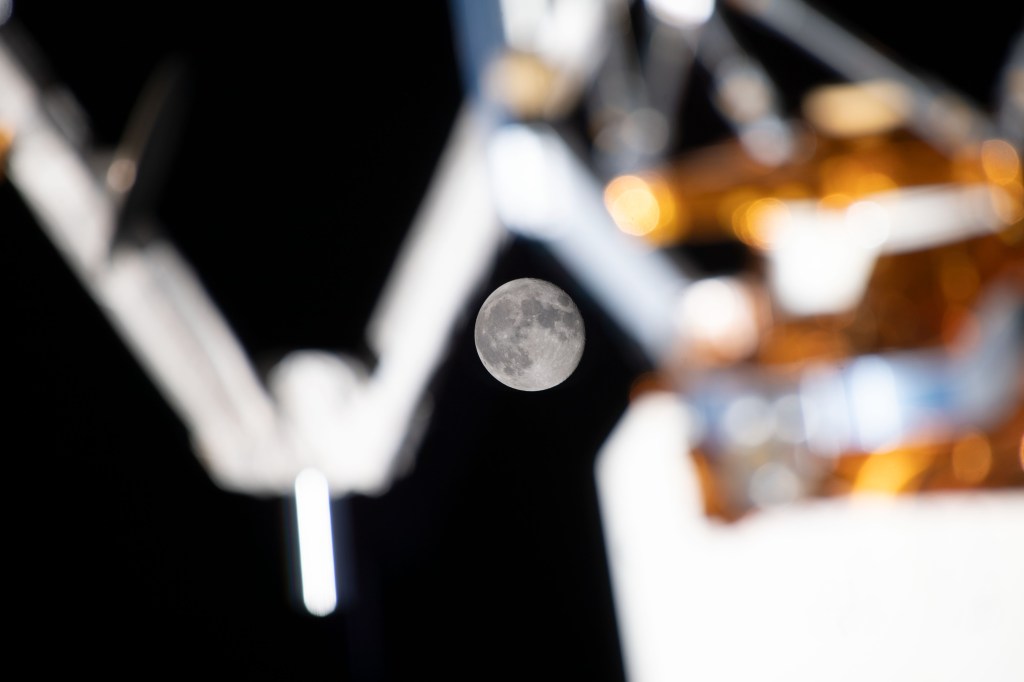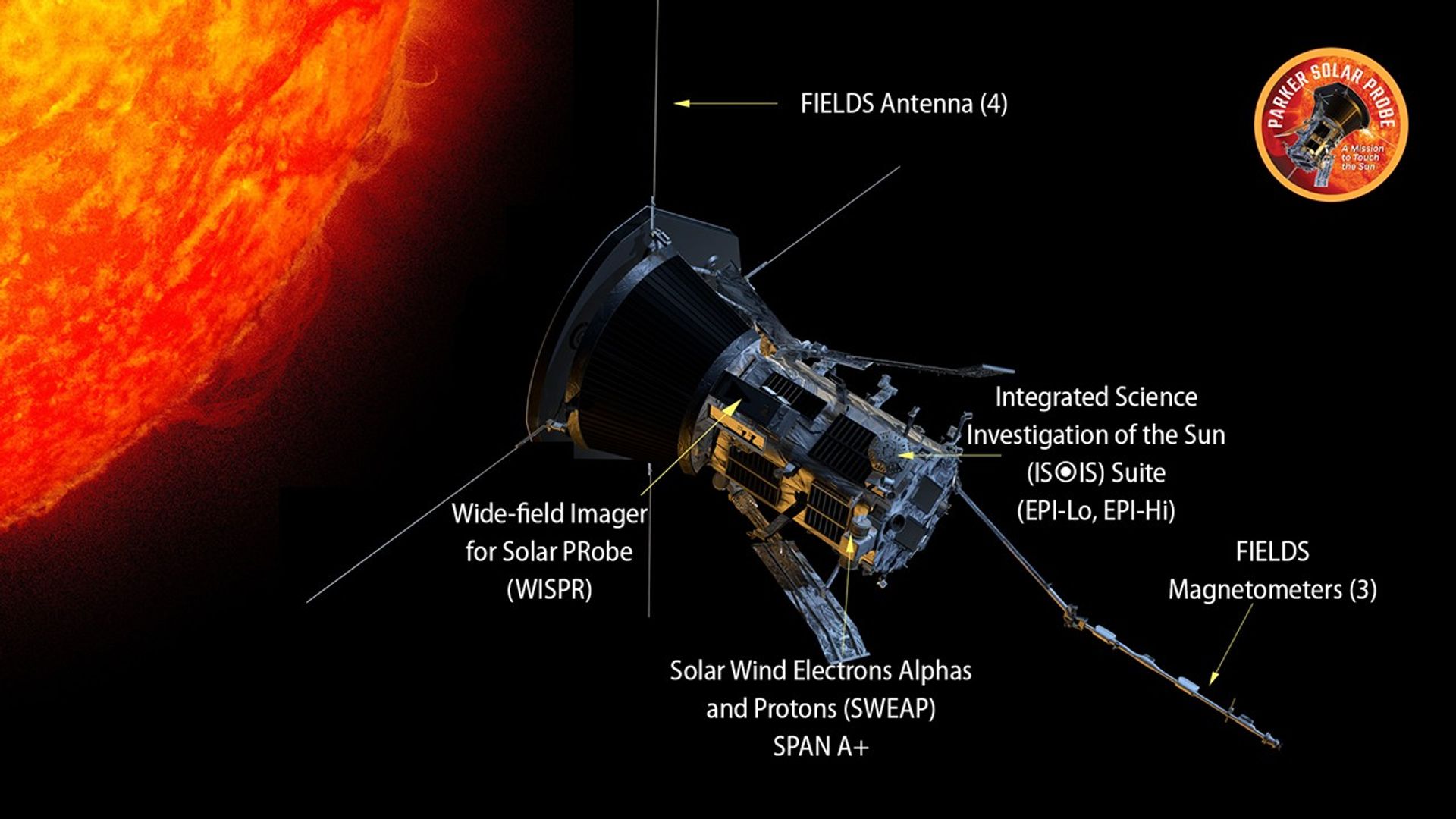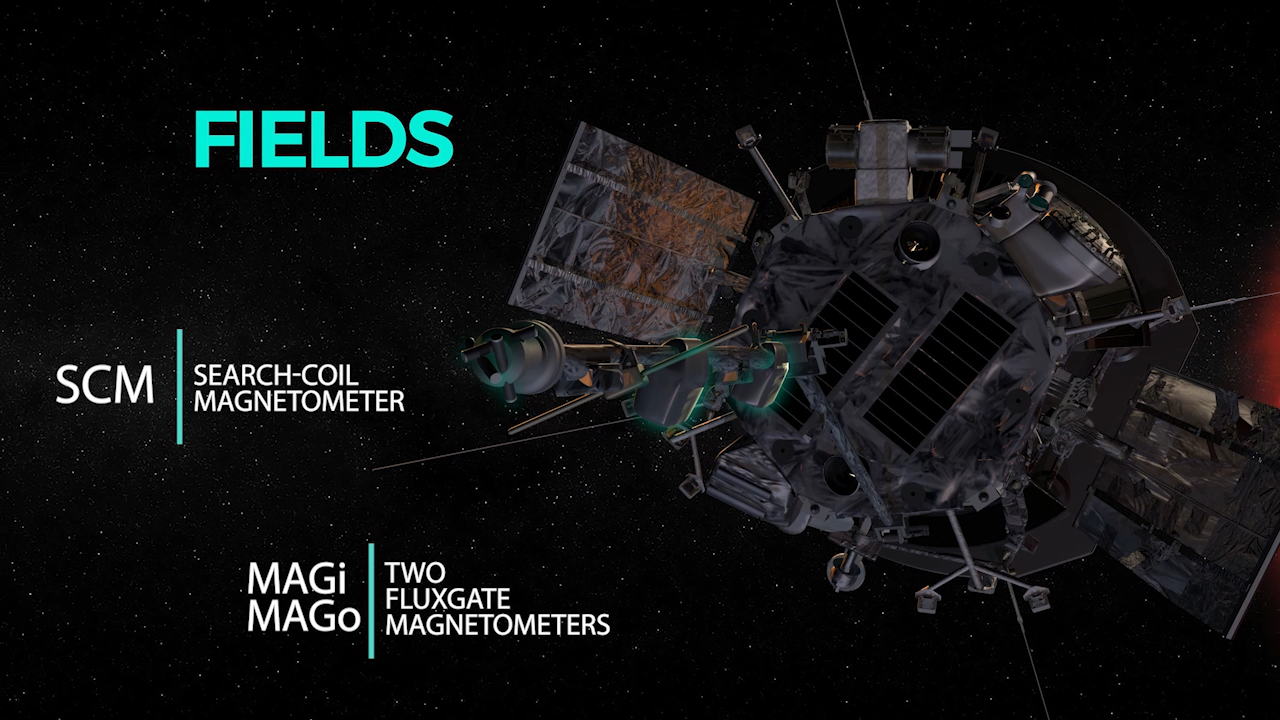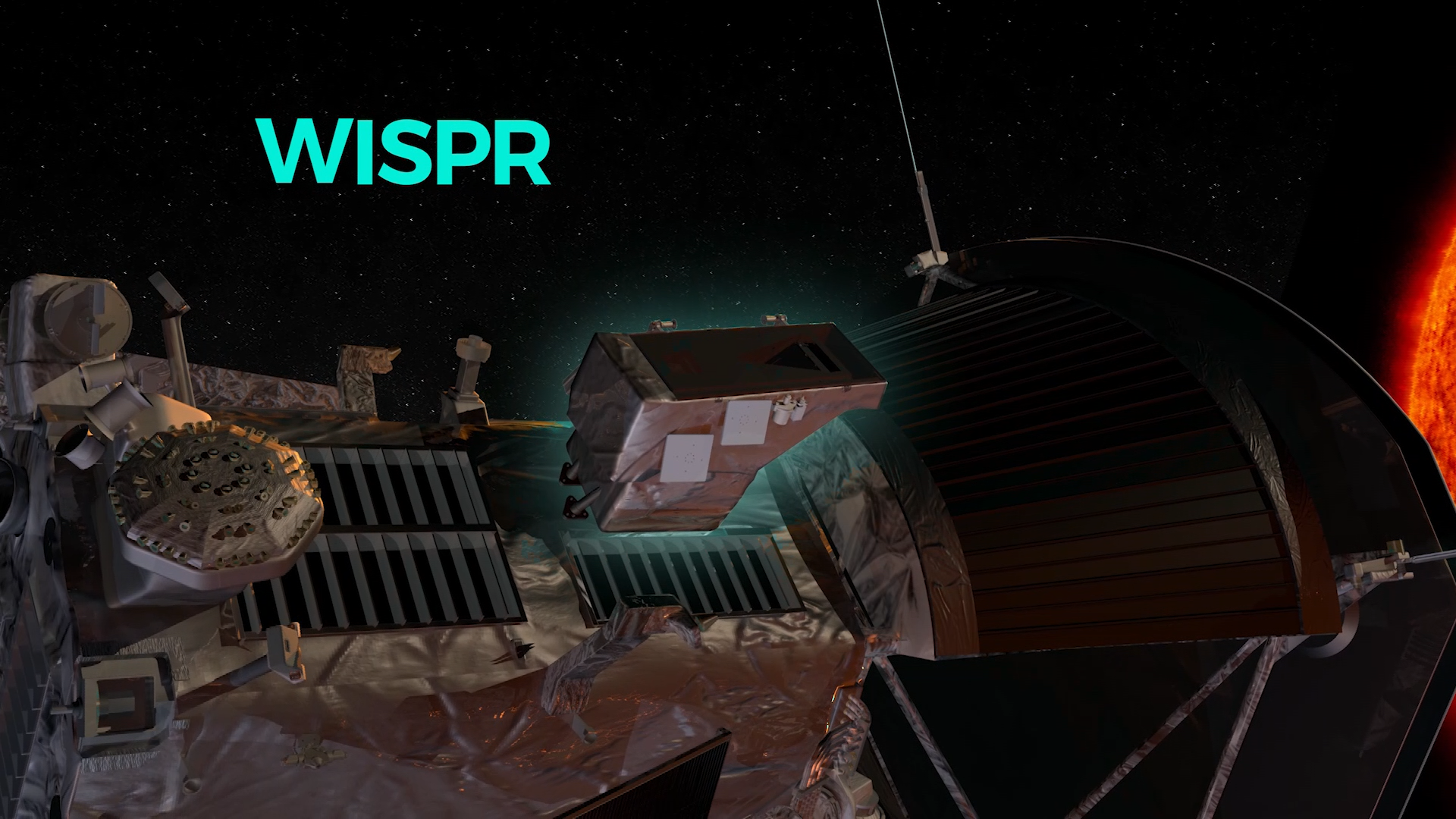Parker Solar Probe Instruments
Parker Solar Probe works under extreme conditions as it gathers data in the Sun’s corona, grazing closer to our star than any spacecraft before. Its four instrument suites characterize the dynamic region close to the Sun by measuring particles and electric and magnetic fields, and each was specially designed to withstand the harsh radiation and temperatures they encounter.
FIELDS
Surveyor of the invisible forces, the FIELDS instrument suite captures the scale and shape of electric and magnetic fields in the Sun’s atmosphere. FIELDS measures waves and turbulence in the inner heliosphere with high time resolution to understand the fields associated with waves, shocks, and magnetic reconnection, a process by which magnetic field lines explosively realign.
FIELDS measures the electric field around the spacecraft with five antennas, four of which stick out beyond the spacecraft’s heat shield and into the sunlight, where they experience temperatures of 2,500 °F. The 2-meter-long antennas are made of a niobium alloy, which can withstand extreme temperatures. FIELDS measures electric fields across a broad frequency range both directly, or in situ, and remotely. Operating in two modes, the four sunlit antennas measure the properties of the fast and slow solar wind — the flow of solar particles constantly streaming out from the Sun. The fifth antenna, which sticks out perpendicular to the others in the shade of the heat shield, helps make a three-dimensional picture of the electric field at higher frequencies.
A trio of magnetometers, each about the size of a fist, help FIELDS assess the magnetic field. A search-coil magnetometer, or SCM, measures how the magnetic field changes over time. Since changing magnetic fields induce a voltage in the coil, it’s possible to track how the magnetic field changes by measuring that voltage. Two identical fluxgate magnetometers, MAGi and MAGo, measure the large-scale coronal magnetic field. The fluxgate magnetometers are specialized for measuring the magnetic field farther from the Sun where it varies at a slower rate, while the search-coil magnetometer is necessary closer to the Sun where the field changes quickly, as it can sample the magnetic field at a rate of two million times per second.
FIELDS was designed, built, and is operated by a team lead by the Space Sciences Laboratory at the University of California, Berkeley (principal investigator Stuart D. Bale).
WISPR
The Wide-Field Imager for Parker Solar Probe is the only imaging instrument aboard the spacecraft. WISPR looks at the large-scale structure of the corona and solar wind before the spacecraft flies through it. About the size of a shoebox, WISPR takes images from afar of structures like coronal mass ejections (CMEs), jets, and other ejecta from the Sun. These structures travel out from the Sun and eventually overtake the spacecraft, where the spacecraft’s other instruments take in-situ measurements. WISPR helps link what’s happening in the large-scale coronal structure to the detailed physical measurements being captured directly in the near-Sun environment.
To image the solar atmosphere, WISPR uses the heat shield to block most of the Sun’s light, which would otherwise obscure the much fainter corona. Specially designed baffles and occulters reflect and absorb the residual stray light that has been reflected or diffracted off the edge of the heat shield or other parts of the spacecraft.
WISPR uses two cameras with radiation-hardened Active Pixel Sensor CMOS detectors. These detectors are used in place of traditional CCDs because they are lighter and use less power. They are also less susceptible to effects of radiation damage from cosmic rays and other high-energy particles, which are a big concern close to the Sun. The camera’s lenses are made of a radiation hard BK7, a common type of glass used for space telescopes, which is also sufficiently hardened against the impacts of dust.
WISPR was designed and developed by the Solar and Heliophysics Physics Branch at the Naval Research Laboratory in Washington, D.C. (principal investigator Russell Howard), which also developed the observing program.
SWEAP
The Solar Wind Electrons Alphas and Protons investigation, or SWEAP, gathers observations using two complementary instruments: the Solar Probe Cup, or SPC, and the Solar Probe Analyzers, or SPAN. The instruments count the most abundant particles in the solar wind — electrons, protons, and helium ions — and measure such properties as velocity, density, and temperature to improve our understanding of the solar wind and coronal plasma.
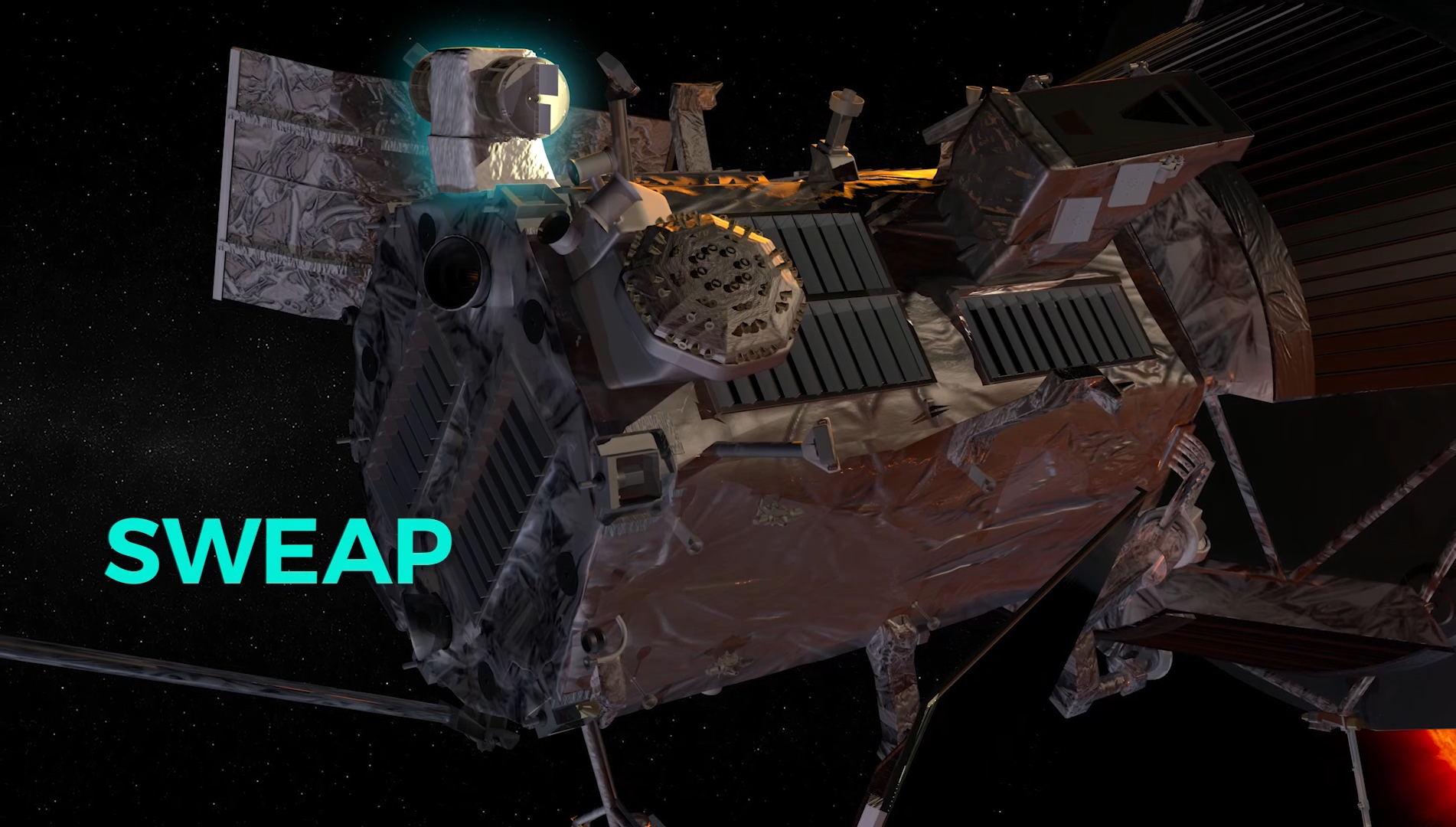
SPC is what’s known as a Faraday cup, a metal device that can catch charged particles in a vacuum. Peeking over the heat shield to measure how electrons and ions are moving, the cup is exposed to the full light, heat, and energy of the Sun. The cup is composed of a series of highly transparent grids — one of which uses variable high voltages to sort the particles — above several collector plates, which measure the particles’ properties. The variable voltage grid also helps sort out background noise, such as cosmic rays and photoionized electrons, which could otherwise bias the measurements. The grids, located near the front of the instrument, can reach temperatures of 3,000 °F, glowing red while the instrument makes measurements. The instrument uses pieces of sapphire to electrically isolate different components within the cup. As it passes close to the Sun, SPC takes up to 146 measurements per second to accurately determine the velocity, density, and temperature of the Sun’s plasma.
SPAN is composed of two instruments, SPAN-A and SPAN-B, which have wide fields of view to allow them to see the parts of space not observed by SPC. Particles encountering the detectors enter a maze that sends the particles through a series of deflectors and voltages to sort the particles based on their mass and charge. While SPAN-A has two components to measure both electrons and ions, SPAN-B looks only at electrons.
SWEAP was built mainly at the Smithsonian Astrophysical Observatory in Cambridge, Massachusetts, and at the Space Sciences Laboratory at the University of California, Berkeley. The institutions jointly operate the instrument. The principal investigator is Justin Kasper from the University of Michigan.
ISʘIS
The Integrated Science Investigation of the Sun — ISʘIS, pronounced “ee-sis” and including the symbol for the Sun in its acronym — uses two complementary instruments in one combined scientific investigation to measure particles across a wide range of energies. By measuring electrons, protons, and ions, ISʘIS will understand the particles’ lifecycles — where they came from, how they became accelerated, and how they move out from the Sun through interplanetary space. The two energetic particle instruments on ISʘIS are called EPI-Lo and EPI-Hi (EPI stands for Energetic Particle Instrument).
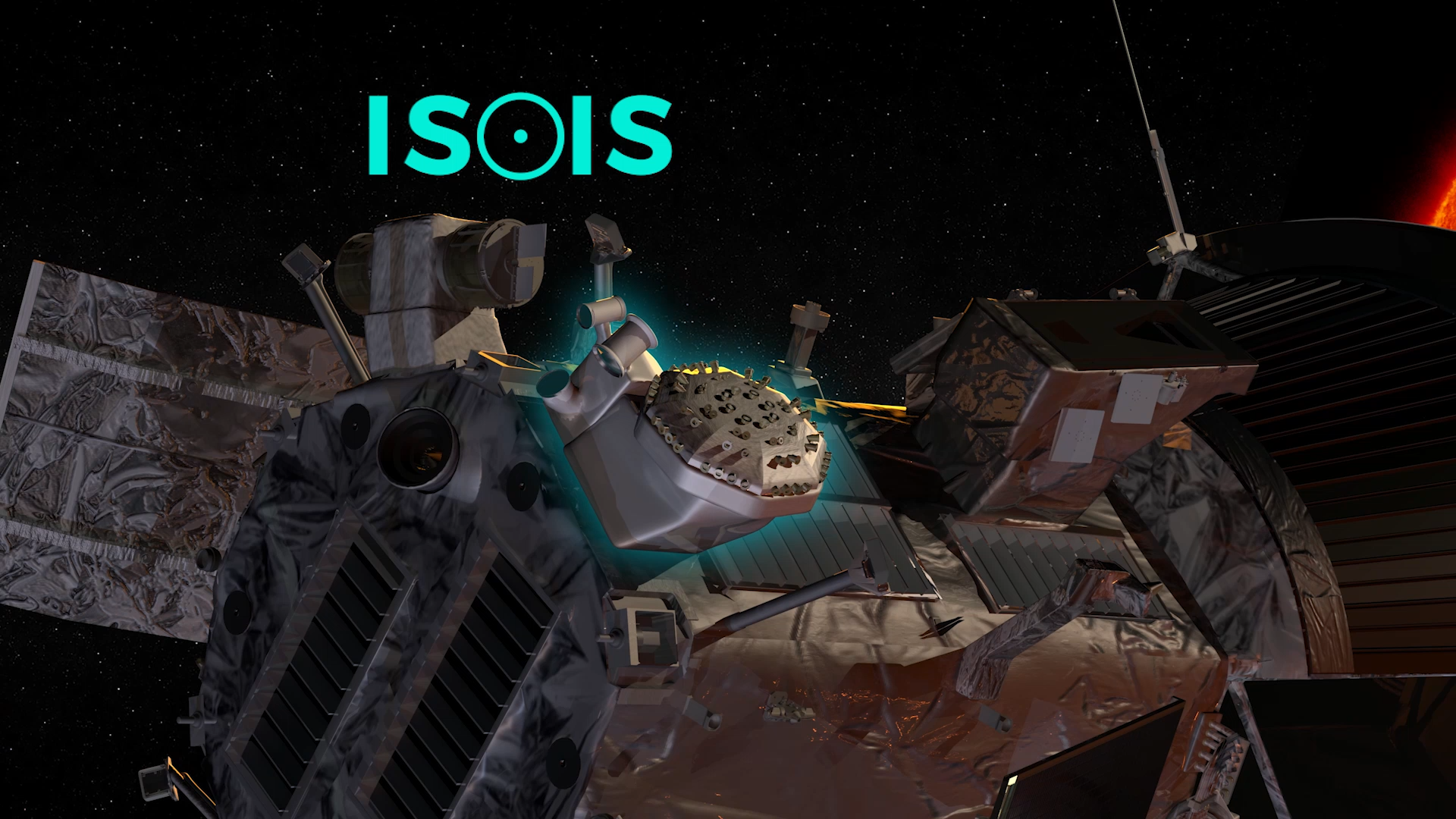
EPI-Lo measures the spectra of electrons and ions and identifies carbon, oxygen, neon, magnesium, silicon, iron, and two isotopes of helium, He-3 and He-4. Distinguishing between helium isotopes will help determine which of several theorized mechanisms caused the particles’ acceleration. The instrument has a unique design — much like a sea urchin — with an octagonal dome body supporting 80 viewfinders, each about the size of a dime. Multiple viewfinders provide a wide field of view to observe low-energy particles. An ion that enters EPI-Lo through one of the viewfinders first passes through two carbon-polyimide-aluminum foils and then encounters a solid-state detector. Upon impact, the foils produce electrons, which are measured by a microchannel plate. Using the amount of energy left by the ion’s impact on the detector and the time it takes the ions to pass through the sensor identifies the species of the particles.
EPI-Hi uses three particle sensors composed of stacked layers of detectors to measure particles with energies higher than those measured by EPI-Lo. The front few layers are composed of ultra-thin silicon detectors made up of geometric segments, which allows for the determination of the particle’s direction and helps reduce background noise. Charged particles are identified by measuring how deep they travel into the stack of detectors and how many electrons they pull off atoms in each detector, a process called ionization. At closest approach to the Sun, EPI-Hi will be able to detect up to 100,000 particles per second.
By using these two instruments together, ISʘIS investigates all energies of solar energetic particles as well as high-energy solar wind particles that cannot be detected by SWEAP.
ISʘIS is led by Princeton University in Princeton, New Jersey (principal investigator David McComas), and was built largely at the Johns Hopkins Applied Physics Laboratory in Laurel, Maryland, and Caltech in Pasadena, California, with significant contributions from Southwest Research Institute in San Antonio, Texas, and NASA’s Goddard Space Flight Center in Greenbelt, Maryland. The ISʘIS Science Operations Center is located at the University of New Hampshire in Durham.

